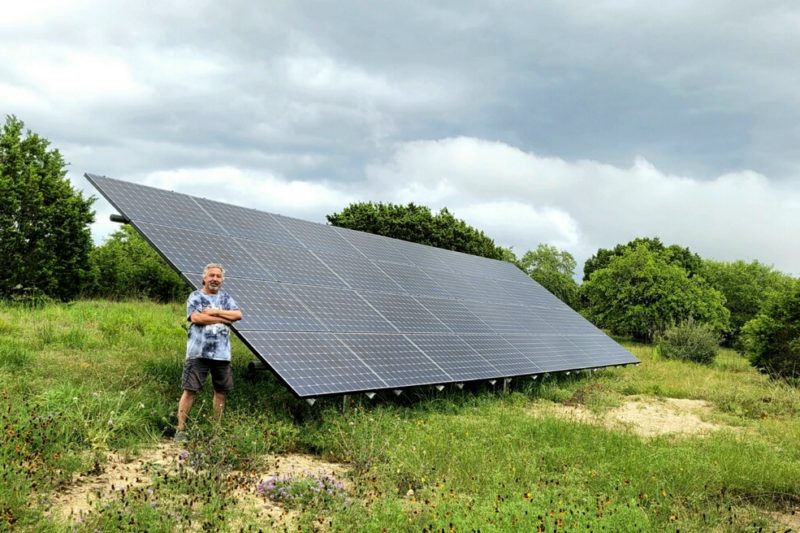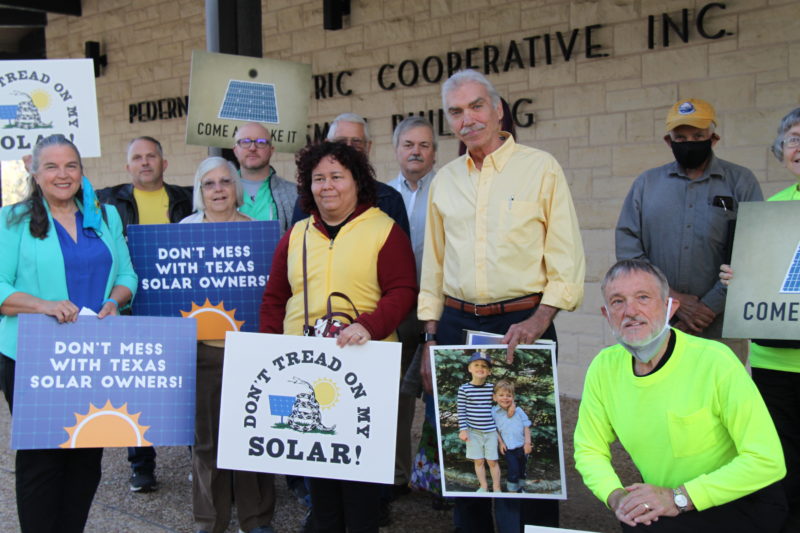Advocates Say Electric Cooperatives Adopting ‘Unfriendly’ Solar Policies
By Jill Ament
Reporting Texas

Richard Hrabik of Liberty Hill, Texas, stands in front of a solar panel array he had installed near his home last year. Photo courtesy of Richard Hrabik
JOHNSON CITY — Liberty Hill resident Richard Hrabik has debated installing solar panels on his home since he moved in 38 years ago.
“I’ve always been interested, but it was never really affordable,” said Hrabik, a retired computer software engineer. “Now panels have gotten to where you can afford them. So, I decided to go for it.”
About a year and a half ago, Hrabik had a solar array — a collection of connected solar panels — installed in his yard.
A home solar array doesn’t typically produce all of the energy a household needs, and homeowners usually still buy some electricity from a utility company.
Hrabik is a customer of the Pedernales Energy Cooperative, the largest electric cooperative in the country. The Johnson City-based cooperative services about 300,000 Texans, and about 5,000 of those customers have solar panels.
Solar panels have reduced Hrabik’s electric bill. Some months the panels provide all the electricity he needs. When his panels produce enough electricity to put back on the grid, PEC buys that surplus from him.
PEC pays solar customers about 9 cents per kilowatt hour for electricity, using a method called net metering.
“You know, I’m going green and I’m not paying out of my pocket to finance my solar, and that’s kind of the way it was,” Hrabik said.
Not long after Hrabik had his panels installed, the PEC’s board of directors in December 2020 proposed a significant rate increase for its customers who have solar panels — a 20-25% increase, according to some estimates. New solar customers would also be charged a one-time $250 solar application fee and a one-time $400 interconnectivity fee.

Pedernales Electric Cooperative customers who use solar panels prepare to protest a rate increase at the cooperative’s board of directors meeting on Nov. 19, 2021, in Johnson City, Texas. They said the proposed increase penalizes solar users. Sumaiya Malik/Reporting Texas
Kaiba White, an energy policy and outreach specialist with Public Citizen Texas, a nonprofit consumer advocacy organization, said PEC didn’t explain these moves adequately to customers. She’s been helping Hrabik and dozens of other PEC solar customers challenge the increases since the summer.
“When members started to find out about this, especially those with solar or who were considering solar, there was an outcry,” White said.
“It’s very frustrating to, you know, to make an investment and then have a utility that is supposed to be working in the best interest of its members turn around and just totally change course and instead of being supportive of solar to actively start attacking,” she added.
Investing in solar panels is like buying a car. The average residential solar panel setup costs between $15,000 and $20,000, according to the Center for Sustainable Energy. Customers often get a loan from solar companies to buy the panels.
The savings are supposed to come through the money a solar customer saves on electric bills. The average utility customer in the Austin area could save nearly $33,000 on electric bills over a span of 25 years by having solar panels. Many solar panel users use the money they save on electricity to recoup the cost of their arrays.
Electric cooperatives such as PEC say they’re seeing more customers purchasing solar panels and using less of their electricity. Despite those customers making up about 2% of PEC’s entire customer base, the co-op says it’s losing $1.3 million a year because of the amount of energy they’re not selling to solar users.
“Over the past five years the number of members with solar has increased significantly,” said J.P. Urban, senior vice president of external affairs for PEC.
“And if this trend continues, the undercollected amount would continue to increase and threaten affordability for all members,” Urban added.
But the trend will continue, said Michael Webber, a professor of energy resources at the University of Texas at Austin’s Cockrell School of Engineering.
“There’s a ton of evidence solar is booming in Texas, and it’s booming in two ways,” Webber said.
“One is rooftop solar panels for people at homes who want to do their part to reduce their electric bill or do their part to reduce CO2 emissions. So rooftop solar panels are really growing in popularity, especially as the cost of solar panels come down, but also utility scale solar farms are really growing in popularity,” Webber said.
As more residential customers opt for solar panels, utility companies that don’t have adequate solar policies in place will see a shortfall in their revenue, he added.
“Utilities have a challenge with the rise of rooftop solar panels, because those solar panels eat into the revenues and therefore the profits that the utilities are going to get,” he said. “From a utilities perspective, they’re still providing grid services. They’re just not getting paid for it. So there’s a real problem, and they’re looking at a variety of remedies.”
After an outcry from PEC customers who use solar panels, the co-op in July revoked the increases it proposed in December 2020. The cooperative has been reworking its rate plan for solar customers and is expected to adopt that plan in early 2022.
PEC is now charging a one-time $250 solar application fee and a one-time $250 interconnectivity fee ($150 less than it’s proposed fee in December 2020) for new customers who have solar panels. And instead of paying solar panel owners 9 cents per kilowatt for their excess electricity, PEC will pay about half of that value.
Kaiba White with Public Citizen-Texas says PEC is undervaluing energy produced by its customers who have solar panels. At a board meeting in November, White and several PEC customers said what the utility is proposing still feels like a disincentive for people to use solar.
“Their current proposal is essentially to eliminate net metering, and any kilowatt hours that are put back onto the grid would be compensated at a set rate,” White said.
Jeff Stubbs was one of more than a dozen PEC customers who have solar panels who spoke out against the new proposed rate plan at the meeting in November. Stubbs is a retired veteran who lives in Kyle. He, like Hrabik, decided to invest in solar panels because he wants to help the environment, and residential panel arrays have become more affordable. He’s on a fixed income, and thought solar panels would help him save money, he said.
“I roughly was paying $300 a month for electricity. I pay on average $25 to $40 a month now, sometimes $8, and I’m trying to hedge inflation from energy costs,” Stubbs said.
Stubbs says the solar rate debate with PEC has been discouraging. He feels like he may be penalized for finding a way to go green that will save money.
“I just feel it’s wrong that solar customers are making the investment,” Stubbs said. “and then they’re going to turn around and take more from solar customers to make it look like we’re the problem.”
Reporter Jill Ament is a PEC customer who recently bought a home with solar panels.